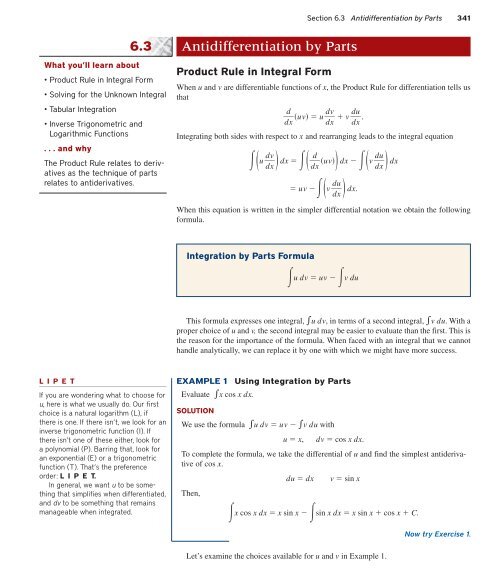5128_Ch06_pp320-376
You also want an ePaper? Increase the reach of your titles
YUMPU automatically turns print PDFs into web optimized ePapers that Google loves.
Section 6.3 Antidifferentiation by Parts 341<br />
6.3<br />
What you’ll learn about<br />
• Product Rule in Integral Form<br />
• Solving for the Unknown Integral<br />
• Tabular Integration<br />
• Inverse Trigonometric and<br />
Logarithmic Functions<br />
. . . and why<br />
The Product Rule relates to derivatives<br />
as the technique of parts<br />
relates to antiderivatives.<br />
Antidifferentiation by Parts<br />
Product Rule in Integral Form<br />
When u and v are differentiable functions of x, the Product Rule for differentiation tells us<br />
that<br />
d<br />
uv u d v<br />
v d u<br />
.<br />
d x dx<br />
dx<br />
Integrating both sides with respect to x and rearranging leads to the integral equation<br />
( u d v<br />
d<br />
) x<br />
( dx d<br />
d<br />
uv) x<br />
( dx v d u<br />
d<br />
) x<br />
dx<br />
uv ( v d u<br />
d<br />
) x<br />
dx.<br />
When this equation is written in the simpler differential notation we obtain the following<br />
formula.<br />
Integration by Parts Formula<br />
u dv uv vdu<br />
This formula expresses one integral, u dv, in terms of a second integral, vdu. With a<br />
proper choice of u and v, the second integral may be easier to evaluate than the first. This is<br />
the reason for the importance of the formula. When faced with an integral that we cannot<br />
handle analytically, we can replace it by one with which we might have more success.<br />
LIPET<br />
If you are wondering what to choose for<br />
u, here is what we usually do. Our first<br />
choice is a natural logarithm (L), if<br />
there is one. If there isn’t, we look for an<br />
inverse trigonometric function (I). If<br />
there isn’t one of these either, look for<br />
a polynomial (P). Barring that, look for<br />
an exponential (E) or a trigonometric<br />
function (T). That’s the preference<br />
order: L IPET.<br />
In general, we want u to be something<br />
that simplifies when differentiated,<br />
and dv to be something that remains<br />
manageable when integrated.<br />
EXAMPLE 1<br />
Evaluate x cos xdx.<br />
SOLUTION<br />
Using Integration by Parts<br />
We use the formula u dv uv vduwith<br />
u x, dv cos xdx.<br />
To complete the formula, we take the differential of u and find the simplest antiderivative<br />
of cos x.<br />
du dx v sin x<br />
Then,<br />
x cos xdx x sin x sin xdx x sin x cos x C.<br />
Now try Exercise 1.<br />
Let’s examine the choices available for u and v in Example 1.












